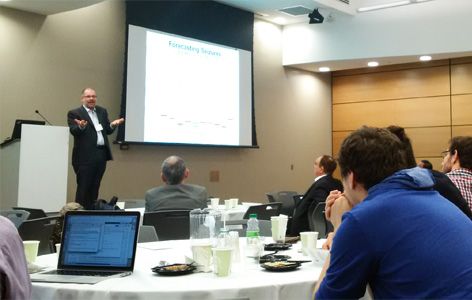Home page Description:
The 2016 Anne & Max Tanenbaum Symposium linked engineering advances with epilepsy research.
Posted On: November 23, 2016

Image Caption:
Visiting speaker Dr. Gregory A. Worrell (pictured above), an expert in the transition from normal brain activity to seizures, described new methods for predicting when an epileptic seizure is going to happen.
The Anne & Max Tanenbaum Symposium on the Frontiers of Science took place on Wednesday November 2, 2016, in the BMO Education & Conference Centre located within the Krembil Discovery Tower. The event was hosted by the Anne & Max Tanenbaum Chair in Cognitive Neuroscience and Krembil Senior Scientist Dr. Peter Carlen.
The theme of this year’s symposium was ‘listening and responding to the brain: neuroengineering and epilepsy’, bridging the latest technological advances in seizure therapeutics and recent findings in basic epilepsy research. The event featured a series of intriguing talks given by leading experts in epilepsy research. The first talk was given by Dr. Carlen, who spoke about the brainstem’s role in seizures and seizure-related death.
The Symposium’s keynote speakers were Dr. Dominique M. Durand from Case Western Research University and Dr. Gregory A. Worrell from the Mayo Clinic. Dr. Durand spoke about harnessing the power of single brain cells to prevent seizures, while Dr. Worrell’s talk focused on methods to forecast future epileptic seizures.
Other speakers included Krembil Scientist Dr. Taufik Valiante, and Drs. Roman Genov and Berj Bardakjian from the University of Toronto. Dr. Valiante talked about potential biological markers that can be used to find the precise brain region where seizures are initiated. Drs. Genov and Bardakjian discussed state-of-the-art electrical stimulation techniques to stop or prevent seizures and new ways to detect the epicenter of seizure activity in the brain, respectively.
“By bringing together leaders in neuroengineering and epilepsy biology to share and exchange their expertise, the Anne & Max Tanenbaum Symposium has helped to foster interdisciplinary collaboration, which will no doubt spark future scientific progress,” says Dr. Carlen.
The theme of this year’s symposium was ‘listening and responding to the brain: neuroengineering and epilepsy’, bridging the latest technological advances in seizure therapeutics and recent findings in basic epilepsy research. The event featured a series of intriguing talks given by leading experts in epilepsy research. The first talk was given by Dr. Carlen, who spoke about the brainstem’s role in seizures and seizure-related death.
The Symposium’s keynote speakers were Dr. Dominique M. Durand from Case Western Research University and Dr. Gregory A. Worrell from the Mayo Clinic. Dr. Durand spoke about harnessing the power of single brain cells to prevent seizures, while Dr. Worrell’s talk focused on methods to forecast future epileptic seizures.
Other speakers included Krembil Scientist Dr. Taufik Valiante, and Drs. Roman Genov and Berj Bardakjian from the University of Toronto. Dr. Valiante talked about potential biological markers that can be used to find the precise brain region where seizures are initiated. Drs. Genov and Bardakjian discussed state-of-the-art electrical stimulation techniques to stop or prevent seizures and new ways to detect the epicenter of seizure activity in the brain, respectively.
“By bringing together leaders in neuroengineering and epilepsy biology to share and exchange their expertise, the Anne & Max Tanenbaum Symposium has helped to foster interdisciplinary collaboration, which will no doubt spark future scientific progress,” says Dr. Carlen.




